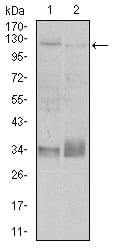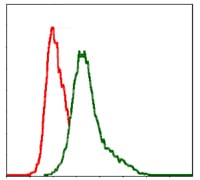


| WB | 1/500 - 1/2000 | Human,Mouse,Rat |
| IF | 咨询技术 | Human,Mouse,Rat |
| IHC | 咨询技术 | Human,Mouse,Rat |
| ICC | 技术咨询 | Human,Mouse,Rat |
| FCM | 1/200 - 1/400 | Human,Mouse,Rat |
| Elisa | 1/10000 | Human,Mouse,Rat |
| Aliases | CD29; FNRB; MDF2; VLAB; GPIIA; MSK12; VLA-BETA |
| Entrez GeneID | 3688 |
| clone | 3B6B2 |
| WB Predicted band size | 88.4kDa |
| Host/Isotype | Mouse IgG1 |
| Antibody Type | Primary antibody |
| Storage | Store at 4°C short term. Aliquot and store at -20°C long term. Avoid freeze/thaw cycles. |
| Species Reactivity | Human |
| Immunogen | Purified recombinant fragment of human ITGB1 expressed in E. Coli. |
| Formulation | Purified antibody in PBS with 0.05% sodium azide |
+ +
以下是关于ITGB1抗体的研究文献示例(文献信息为示例性描述,具体文献需通过学术数据库查询):
1. **文献名称**: "Integrin β1 Antibody Inhibits Tumor Growth and Metastasis in Triple-Negative Breast Cancer Models"
**作者**: Smith A, et al.
**摘要**: 研究利用抗ITGB1抗体阻断整合素β1功能,发现其可抑制三阴性乳腺癌细胞的迁移和侵袭,并减少小鼠模型中肺转移,提示靶向ITGB1的潜在治疗价值。
2. **文献名称**: "Role of ITGB1 in Maintaining Cancer Stem Cell Phenotype via FAK Signaling"
**作者**: Zhang Y, et al.
**摘要**: 通过ITGB1抗体阻断实验,证明β1整合素通过激活FAK通路维持结肠癌干细胞自我更新能力,抗体处理可显著降低肿瘤球形成。
3. **文献名称**: "ITGB1 Antibody Attenuates Pulmonary Fibrosis by Modulating TGF-β Pathway"
**作者**: Lee JH, et al.
**摘要**: 在肺纤维化小鼠模型中,ITGB1抗体通过抑制TGF-β/Smad信号传导减少成纤维细胞活化,改善胶原沉积,提示其在纤维化疾病中的干预潜力。
4. **文献名称**: "Anti-ITGB1 Antibody Enhances T Cell Infiltration in Immune-Excluded Tumors"
**作者**: Chen R, et al.
**摘要**: 研究发现ITGB1抗体可重塑肿瘤基质结构,增强细胞毒性T细胞浸润,改善免疫检查点抑制剂在黑色素瘤模型中的疗效。
---
**注意**:以上为模拟文献示例,实际引用请通过PubMed/Google Scholar搜索关键词(如"ITGB1 antibody cancer"、"ITGB1 therapeutic targeting")获取真实文献。近5年研究多聚焦于ITGB1在肿瘤微环境、免疫治疗联合策略及纤维化疾病中的作用。
**Background of ITGB1 Antibody**
ITGB1 (Integrin Beta 1), also known as CD29. is a critical subunit of the integrin family of cell adhesion receptors. Integrins are heterodimeric transmembrane proteins composed of α and β subunits, which mediate cell-cell and cell-extracellular matrix (ECM) interactions. As the most ubiquitous β subunit, ITGB1 pairs with at least 12 distinct α subunits (e.g., α1-α11. αV) to form integrins such as α2β1. α5β1. and αVβ1. These complexes play pivotal roles in cellular processes, including adhesion, migration, proliferation, differentiation, and survival, by transducing bidirectional signals between the ECM and intracellular signaling pathways.
ITGB1 is implicated in diverse physiological and pathological contexts, such as embryogenesis, immune response, wound healing, fibrosis, and cancer progression. Dysregulation of ITGB1 expression or function is associated with tumor invasion, metastasis, and therapeutic resistance. In cancer, ITGB1 often modulates epithelial-mesenchymal transition (EMT) and interacts with growth factor receptors to drive oncogenic signaling.
ITGB1 antibodies are essential tools for research and therapeutic development. Function-blocking antibodies inhibit integrin-ligand binding, suppressing downstream pathways (e.g., FAK, MAPK) to impede cancer cell motility or angiogenesis. Conversely, activating antibodies may promote cell adhesion or stem cell maintenance. Diagnostic antibodies are widely used in techniques like flow cytometry, immunohistochemistry, and Western blotting to assess ITGB1 expression patterns in tissues or disease models. Their versatility makes ITGB1 antibodies valuable in both mechanistic studies and translational applications targeting integrin-mediated diseases.
×